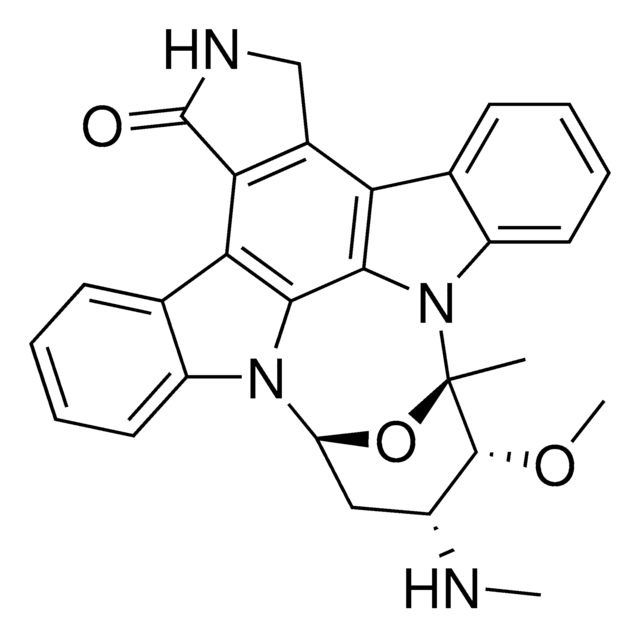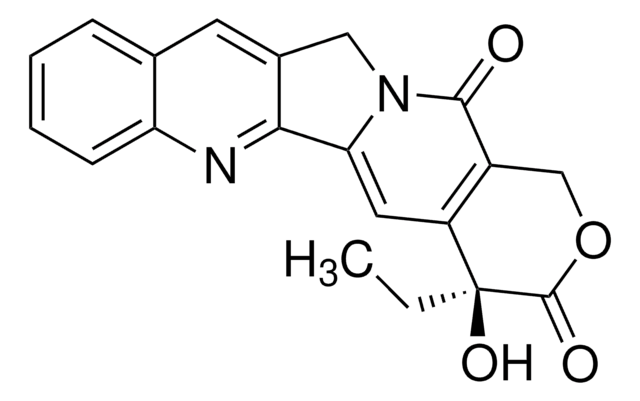APT800
Apoptosis Inducer Set
Apoptosis Inducer Set contains Actinomycin D, Camptothecin, Cycloheximide, Dexamethasone & Etoposide. These compounds can be used for inducing apoptotic activity in many cell culture systems.
Sinónimos:
5 Apotosis Inducers
About This Item
Productos recomendados
Quality Level
form
liquid
species reactivity (predicted by homology)
mammals
manufacturer/tradename
Chemicon®
technique(s)
activity assay: suitable
shipped in
dry ice
General description
Camptothecin: Powerful anti-tumor agent. Camptoethecin is an inhibitor of DNA-topoisomerase I. The drug activates the p53 resulting in upregulated expression of TRAIL-R2 (DR5) and Bak to overcome TRAIL resistance in Bax-deficient human colon carcinoma cancer cells. In addition, Camptoethecin induced apoptosis can be increased by the presence of cytokines such as TNF via its subsequent inhibition of NFkappa B {Valente P et al Eur J Cancer (2003) 39:1468-77}.
Cycloheximide: A potent protein translation inhibitor which results in the inhibition of protein synthesis and subsequent arrest of cell growth and induction of cell death. Cycloheximide also facilitates apoptosis induction via FasL, however, cycloheximide can also prevent apoptosis in some systems, such as thalassemic serum induction of HUVEC cells {Banjerdpong, R. (1998) Ph.D Thesis Mahidol Univ. Bangkok, Thailand}.
Dexamethasone: Classic inducer of apoptosis in thymocytes; a glucocorticoid anti-inflammatory agent. Regulates T cell survival, growth and differientiation; modulator of nitric oxide synthase. Induces apoptosis in thymocytes as well as other immune cells like microglia. However, like other apoptotic inducers, dexamethasone can suppress apoptosis in certain systems through the activation of anti-apoptotic proteins such as bcl-X {Chang, et al (1997) FEBS Letter 415:11-15}.
Etoposide: Potent topoisomerase II inhibitor. An anti-tumor agent that enhances dsDNA & ssDNA cleavage and inhibits DNA religation. Inhibits the cell cycle in the S-phase and induces apoptosis in normal and tumor cell lines, but can be modulated by intracellular levels of cAMP and other factors {Bermejo, L et al (1998) J. Cell Sci 111:637-644;Solovyyan, V et al. (1998) Brain Res Mol Brain Res 62:43-55}
Application
Apoptosis & Cancer
Components
· Camptothecin (2 mM): 1 mL
· Cycloheximide (100 mM): 1 mL
· Dexamethasone (10 mM): 1 mL
· Etoposide (10 mM): 100 μL
Physical form
Storage and Stability
WARNING: Kit contains highly toxic agents; professional users only; wear gloves and other protective equipment and good laboratory practices when manipulating the concentrated and diluted solutions.
Legal Information
Disclaimer
signalword
Danger
Hazard Classifications
Acute Tox. 3 Oral - Aquatic Chronic 3 - Carc. 1B - Muta. 1B - Repr. 1B
Storage Class
6.1C - Combustible acute toxic Cat.3 / toxic compounds or compounds which causing chronic effects
flash_point_f
188.6 °F
flash_point_c
87 °C
Certificados de análisis (COA)
Busque Certificados de análisis (COA) introduciendo el número de lote del producto. Los números de lote se encuentran en la etiqueta del producto después de las palabras «Lot» o «Batch»
¿Ya tiene este producto?
Encuentre la documentación para los productos que ha comprado recientemente en la Biblioteca de documentos.
Nuestro equipo de científicos tiene experiencia en todas las áreas de investigación: Ciencias de la vida, Ciencia de los materiales, Síntesis química, Cromatografía, Analítica y muchas otras.
Póngase en contacto con el Servicio técnico










